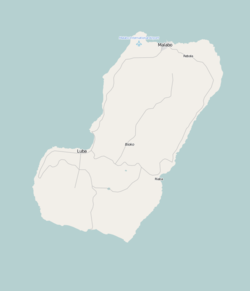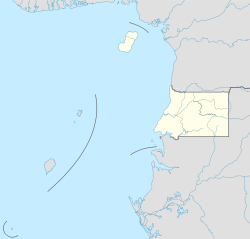
Malabo
About this schools Wikipedia selection
SOS Children, which runs nearly 200 sos schools in the developing world, organised this selection. SOS Children works in 45 African countries; can you help a child in Africa?
| Malabo | |||
|---|---|---|---|
|
|||
| Nickname(s): nick | |||
|
|
|||
|
|
|||
| Coordinates: 3°45′7.43″N 8°46′25.32″E | |||
| Country | |||
| Province | Bioko Norte Province | ||
| Founded | 1827 (as "Port Clarence") | ||
| Current name | Since 1973 | ||
| Elevation | 0 m (0 ft) | ||
| Population (2012) | |||
| • Total | 187,302 | ||
| Demonym | Malabeño-a | ||
| Time zone | WAT ( UTC+1) | ||
| Website | www.ayuntamientodemalabo.com | ||
Malabo (pron.: / m ə ˈ l ɑː b oʊ /) is the capital of Equatorial Guinea, located on the northern coast of Bioko Island (formerly Fernando Pó) on the rim of a sunken volcano. With a population of 155,963 (2005) it is also the second largest city in the country, after Bata in Río Muni on the African mainland. Oyala is a planned city currently under construction, designed to replace Malabo as the capital.
History
The city was first founded by the British in 1827, who leased the island from Spain during the colonial period. Named Port Clarence, it was used as a naval station in the effort to suppress the slave trade. Many newly freed slaves were also settled there, prior to the establishment of Liberia as a colony for freed slaves. While many of them later relocated to Sierra Leone, some of their descendants, called Fernandinos, can still be found in Malabo and the surrounding area, where they constitute a distinct ethnic group, speaking their own Afro-Portuguese pidgin dialect.
When the island reverted to complete Spanish control, Malabo was renamed Santa Isabel. It was chosen to replace the mainland city of Bata as the capital of the country in 1969, and was renamed Malabo in 1973 as part of President Francisco Macías Nguema's campaign to replace European place names with "authentic" African ones.
Climate
Despite its location near the equator, Malabo features a tropical wet and dry climate. Malabo sees on average 1,800 mm of rain per year. The city has a pronounced, albeit short dry season from December through February. January is normally driest with just 5 mm (0.2 in) of rain falling on average. It also has a very lengthy wet season that covers the remaining nine months. On average, the months hit hardest by the wet season are from September to October, with 500 millimetres (20 in) of rain falling between them.
Daytime temperatures do not vary at all day to day, and only vary a few degrees throughout the entire year. At night, the average low temperature is 21-22 degrees in every month of the year, apart from January when average low is 19 degrees). January has cooler nights and hotter days because it has clearer weather. Nonetheless, Malabo, with only 1,180 hours of sunshine per year, is one of the gloomiest capitals in the world and experiences much fog even when it is not raining.
| Climate data for Malabo | |||||||||||||
|---|---|---|---|---|---|---|---|---|---|---|---|---|---|
| Month | Jan | Feb | Mar | Apr | May | Jun | Jul | Aug | Sep | Oct | Nov | Dec | Year |
| Average high °C (°F) | 31 (88) |
32 (90) |
31 (88) |
32 (90) |
31 (88) |
29 (84) |
29 (84) |
29 (84) |
30 (86) |
30 (86) |
30 (86) |
31 (88) |
30 (86) |
| Daily mean °C (°F) | 25 (77) |
26 (79) |
26 (79) |
26 (79) |
25 (77) |
25 (77) |
24 (75) |
24 (75) |
24 (75) |
24 (75) |
25 (77) |
25 (77) |
24.9 (76.8) |
| Average low °C (°F) | 19 (66) |
21 (70) |
21 (70) |
21 (70) |
22 (72) |
21 (70) |
21 (70) |
21 (70) |
21 (70) |
21 (70) |
22 (72) |
21 (70) |
21 (70) |
| Rainfall mm (inches) | 42 (1.65) |
33 (1.3) |
110 (4.33) |
187 (7.36) |
179 (7.05) |
224 (8.82) |
284 (11.18) |
188 (7.4) |
277 (10.91) |
238 (9.37) |
92 (3.62) |
36 (1.42) |
1,890 (74.41) |
| Avg. rainy days (≥ 0.1 mm) | 4 | 4 | 11 | 14 | 18 | 21 | 21 | 18 | 23 | 20 | 13 | 5 | 172 |
| % humidity | 86 | 85 | 90 | 89 | 87 | 90 | 90 | 92 | 95 | 94 | 93 | 91 | 90.2 |
| Mean monthly sunshine hours | 148.8 | 152.5 | 108.5 | 120.0 | 117.8 | 69.0 | 46.5 | 58.9 | 48.0 | 68.2 | 99.0 | 139.5 | 1,176.7 |
| Source: Climate & Temperature | |||||||||||||
Layout
Despite its status as the capital of Equatorial Guinea for several decades, Malabo's street network remains poorly developed. Malabo itself has few paved roads leading into it, and fewer than one hundred paved and developed streets. Many of the street names reflect an African nationalist or anti-colonial theme, with names such as "Independence Avenue" or " Patrice Lumumba Road" being main roads. The few large roads not named for an African nationalist ideal or person are named for cities in Equatorial Guinea or other places or countries in Africa, as well as the road leading to the presidential palace. The palace and grounds consume a substantial part of the eastern side of Malabo, and are off-limits. The heart of the city is the colonial cathedral at Independence Place. Many buildings in the city from the Spanish colonial era are still standing.
The south of Malabo is bordered by the Rio Consul. Across this lies the hospital to the southeast. To the west is the recently renovated Malabo Airport. The coastal northern region of the city is pierced by headlands and bays. The largest headland is the crescent-shaped Tip of African Unity behind the presidential palace. Encompassing the entire eastern side of Malabo Bay, it is almost as long as Malabo is tall. Malabo is part of a wider bay that represents most of the northern coast of Bioko; it stretches from Europe Point in the west (home to the airport), to barren lands in the east.
Notable buildings in Malabo include Malabo Cathedral, Malabo Government Building and the Malabo Court Building. The city is served by Malabo International Airport, while ferries sail from its port to Douala and Bata. The city contains several notable hotels including Sofitel Malabo President Palace, Hotel Ureka, Hotel Bahia and Hotel Impala.
Discovery of oil
Malabo has been significantly affected by Teodoro Obiang Nguema Mbasogo's growing co-operation with the oil industry. The country's production has reached 360,000 barrels per day (57,000 m3/d) as of 2004, an increase which led to a doubling of the city's population, but for the vast majority, very little of that wealth has been invested in development.
Education
The Colegio Nacional Enrique Nvó Okenve has campuses here and in Bata.
Transportation
Malabo International Airport serves Malabo. Several domestic and international carriers fly into Malabo.






